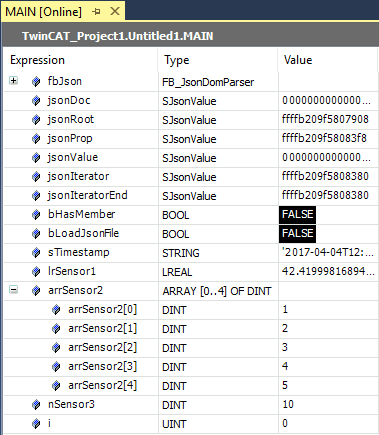Getting started
This documentation article is intended as a quick-start guide to using the Tc3_JsonXml PLC library. The article is based on the following use case:
- A JSON document exists that is to be processed further.
- The JSON document is in the form of a file on the local file system.
- The article describes the steps to parse the JSON document.
For more code samples, please refer to our samples.
File contents
The file myJsonContent.json is located in the local file system under the following path: c:\temp\myJsonContent.json and has the following content:
{
"Timestamp":"2017-04-04T12:42:42",
"Values": {
"Sensor1": 42.41999816894531,
"Sensor2": [1,2,3,4,5],
"Sensor3": 10
}
}Declarations
The following variable declarations are required for the further procedure:
fbJson : FB_JsonDomParser;
jsonRoot : SJsonValue;
jsonProp : SJsonValue;
jsonIterator : SJsonValue;
jsonIteratorEnd : SJsonValue;
bLoadJsonFile : BOOL;
sTimestamp : STRING;
fSensor1 : LREAL;
aSensor2 : ARRAY[0..4] OF DINT;
nSensor3 : DINT;
i : UINT;Furthermore, please make sure that you have added a reference to the PLC library Tc3_JsonXml in your PLC project.
Reading the file
The method LoadDocumentFromFile from the function block FB_JsonDomParser is used to read the file. The execution of the method is controlled by a rising edge at input bExec.
IF bLoadJsonFile = TRUE THEN
fbJson.LoadDocumentFromFile('C:\Temp\myJsonContent.json', bLoadJsonFile);
END_IF | Source of the JSON document If in your use case the JSON document already exists in the PLC, e.g. in a variable of data type STRING, you can use the method ParseDocument to load the document into memory and for further processing. |
Parsing the JSON document
The GetDocumentRoot method can be used to reference the beginning of the JSON document in memory. The return value of the method is an interface pointer.
jsonRoot := fbJson.GetDocumentRoot();From here, the other keys on the first level can be read, e.g. the 'Timestamp' key via the method GetString:
jsonProp := fbJson.FindMember(jsonRoot, 'Timestamp');
IF (jsonProp <> 0) THEN
sTimestamp := fbJson.GetString(jsonProp);
END_IFThe next key ('Values') is a nested JSON object. The child elements of this object can be read directly via the method FindMemberPath, for example for the element 'Values/Sensor1':
jsonProp := fbJson.FindMemberPath(jsonRoot, 'Values/Sensor1');
IF (jsonProp <> 0) THEN
fSensor1 := fbJson.GetDouble(jsonProp);
END_IFThe next child element ('Values/Sensor2') is an array. This can be read by using the methods ArrayBegin and ArrayEnd.
jsonProp := fbJson.FindMemberPath(jsonRoot, 'Values/Sensor2');
IF (jsonProp <> 0) THEN
jsonIterator := fbJson.ArrayBegin(jsonProp);
jsonIteratorEnd := fbJson.ArrayEnd(jsonProp);
WHILE jsonIterator <> jsonIteratorEnd DO
IF (jsonProp <> 0) THEN
aSensor2[i] := fbJson.GetInt(jsonIterator);
END_IF
jsonIterator := fbJson.NextArray(jsonIterator);
i := i + 1;
END_WHILE
i := 0;
END_IFHandling of the next child element ('Values/Sensor3') is similar to the element 'Values/Sensor1'. Instead of the method GetDouble the method GetInt is used to read the value of the key.
jsonProp := fbJson.FindMemberPath(jsonRoot, 'Values/Sensor3');
IF (jsonProp <> 0) THEN
nSensor3 := fbJson.GetInt(jsonProp);
END_IFComplete code sample
Below you will find the above code snippets as a complete sample.
Declaration part
PROGRAM MAIN
fbJson : FB_JsonDomParser;
jsonRoot : SJsonValue;
jsonProp : SJsonValue;
jsonIterator : SJsonValue;
jsonIteratorEnd : SJsonValue;
bLoadJsonFile : BOOL;
sTimestamp : STRING;
fSensor1 : LREAL;
aSensor2 : ARRAY[0..4] OF DINT;
nSensor3 : DINT;
i : UINT;
END_VARImplementation part
IF bLoadJsonFile = TRUE THEN
fbJson.LoadDocumentFromFile('C:\Temp\myJsonContent.json', bLoadJsonFile);
jsonRoot := fbJson.GetDocumentRoot();
jsonProp := fbJson.FindMember(jsonRoot, 'Timestamp');
IF (jsonProp <> 0) THEN
sTimestamp := fbJson.GetString(jsonProp);
END_IF
jsonProp := fbJson.FindMemberPath(jsonRoot, 'Values/Sensor1');
IF (jsonProp <> 0) THEN
fSensor1 := fbJson.GetDouble(jsonProp);
END_IF
jsonProp := fbJson.FindMemberPath(jsonRoot, 'Values/Sensor2');
IF (jsonProp <> 0) THEN
jsonIterator := fbJson.ArrayBegin(jsonProp);
jsonIteratorEnd := fbJson.ArrayEnd(jsonProp);
WHILE jsonIterator <> jsonIteratorEnd DO
IF (jsonProp <> 0) THEN
aSensor2[i] := fbJson.GetInt(jsonIterator);
END_IF
jsonIterator := fbJson.NextArray(jsonIterator);
i := i + 1;
END_WHILE
i := 0;
END_IF
jsonProp := fbJson.FindMemberPath(jsonRoot, 'Values/Sensor3');
IF (jsonProp <> 0) THEN
nSensor3 := fbJson.GetInt(jsonProp);
END_IF
END_IFAfter the above code has been executed successfully, the keys that were read out are in the corresponding PLC variables, e.g. as follows:
